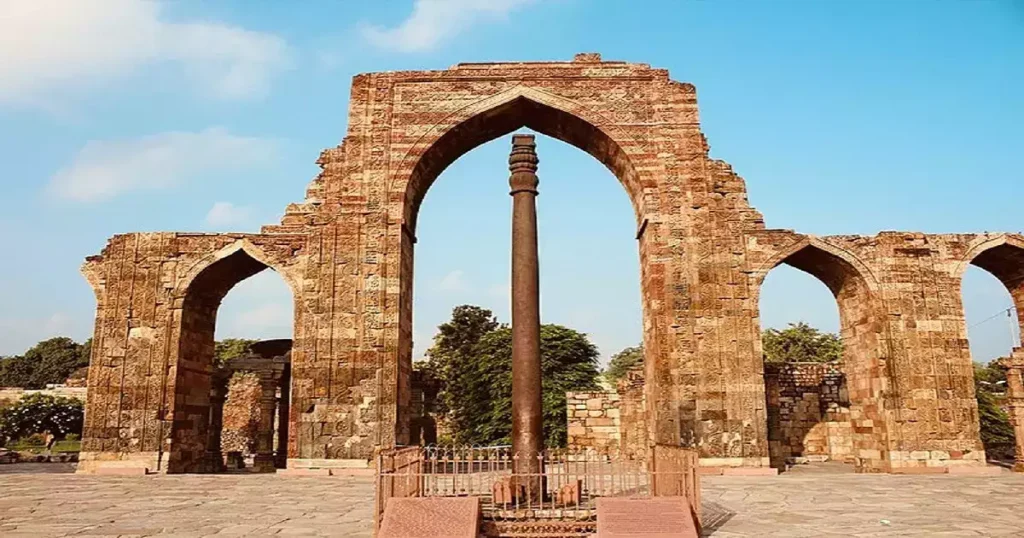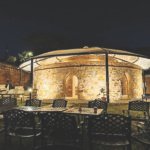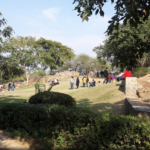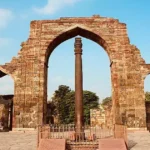The Iron Pillar in Mehrauli, Delhi, is a remarkable ancient monument that has stood the test of time for over 1,600 years. It is a testament to the engineering prowess of ancient India, and a symbol of the country’s rich cultural heritage.
The pillar is made of solid iron and has survived centuries of exposure to the elements, including rain, sun, and wind. Despite being made of iron, the pillar has not rusted, which is a testament to the metallurgical expertise of the ancient Indians.
The Iron Pillar is located in the Qutub Minar Complex in Mehrauli, Delhi, which is a UNESCO World Heritage Site. The pillar is 7.21 meters (23 feet 8 inches) tall, with a diameter of 41 centimeters (16 inches), and weighs over six tons.
The pillar was erected during the reign of Chandragupta II, who ruled from c. 375-415 CE. The pillar bears an inscription in Sanskrit that describes the achievements of the Gupta dynasty. The pillar is also famous for its rust-resistant composition, which has puzzled scientists and metallurgists for centuries.
Historical Significance of Iron Pillar in Mehrauli
The Iron Pillar of Mehrauli is a significant historical monument that has stood the test of time. It is a testament to the scientific and engineering advancements of ancient India.
The pillar is believed to have been constructed during the reign of King Chandragupta II, who ruled from 375-415 CE.
Cultural Importance
The Iron Pillar of Mehrauli is not just a historical monument, but also holds immense cultural importance. The pillar is located in the Qutub Complex in Mehrauli, Delhi, which is a UNESCO World Heritage site.
The complex is home to several other historical structures, including the Qutub Minar and the Quwwat-ul-Islam Mosque.
The Iron Pillar is also significant because of its association with Hindu mythology. It is believed that the pillar was originally topped with an emblem of the mythical bird Garuda, which is the symbol of the Gupta dynasty.
The pillar is also associated with the god Vishnu, who is often depicted holding a mace or club, similar to the shape of the pillar.
Inscriptions and Epigraphy
The Iron Pillar of Mehrauli is also significant because of the inscriptions and epigraphy that adorn its surface. The pillar is covered with inscriptions in Sanskrit and Brahmi script, which provide important historical information about the Gupta dynasty.
One of the most notable inscriptions on the pillar is a dedication to King Chandragupta II, which reads, “He, who, having crossed the ocean and the mountain, has conquered the whole world, has left the mark of the emblem of the Gupta dynasty on the earth.”
The inscription is a testament to the military prowess of the Gupta dynasty and their achievements in expanding their empire.
Overall, the Iron Pillar of Mehrauli is a significant historical monument that provides valuable insights into the scientific, engineering, and cultural achievements of ancient India.
Its inscriptions and epigraphy provide important historical information about the Gupta dynasty, and its association with Hindu mythology adds to its cultural significance.
Physical Description
The Iron Pillar of Mehrauli is a freestanding, rust-resistant iron column located in the Qutub Complex in Delhi, India. It stands at a height of 7.21 meters (23 feet 8 inches) with a diameter of 41 centimeters (16 inches) and weighs approximately 6,000 kg.
The pillar is notable for its remarkable resistance to corrosion and rust, despite being over a thousand years old.
Material Composition
The Iron Pillar is made of 98% wrought iron, with trace amounts of phosphorus, sulfur, and manganese. The iron used in its construction has a unique composition that makes it resistant to rust and corrosion.
According to some theories, the iron used in the pillar was obtained from meteorites, which contain a high proportion of nickel and cobalt, making them resistant to rust.
Structural Features
The Iron Pillar has a circular cross-section and is composed of several segments that were welded together. The pillar has a fluted shaft with a bell-shaped capital at the top. The capital is decorated with a lotus design, with inscriptions in the Sanskrit language.
The pillar is also adorned with several small bells, which are said to have been added during the Mughal period.
Overall, the Iron Pillar of Mehrauli is a remarkable feat of engineering and metallurgy. Its unique composition and structural features have allowed it to withstand the test of time and remain one of the most iconic structures in India.
Preservation and Conservation
Environmental Challenges
The Iron Pillar in Mehrauli has been standing for over 1500 years, and its preservation has been a challenge due to the environmental factors that have affected it. The pillar is made of iron, which is prone to rusting and corrosion.
The humid and polluted air of Delhi has accelerated the corrosion process, and the pillar has developed a layer of rust over the years.
Moreover, the presence of microorganisms such as bacteria, fungi, and algae has also contributed to the degradation of the pillar. These microorganisms feed on the iron and produce acidic byproducts that corrode the metal.
The presence of birds and bats that roost on the pillar has also caused damage due to their droppings.
Restoration Efforts
To preserve the Iron Pillar, several restoration efforts have been undertaken over the years. The Archaeological Survey of India (ASI) has been responsible for the maintenance and conservation of the pillar.
They have taken several measures to protect the pillar from further damage.
One of the measures taken was the installation of a protective fence around the pillar to prevent birds and bats from roosting on it. The ASI has also applied a protective coating on the pillar to prevent further rusting.
They have regularly cleaned the pillar to remove the layer of rust and prevent the growth of microorganisms.
In addition to these measures, the ASI has also conducted research to understand the corrosion process and develop new methods to preserve the pillar.
They have collaborated with scientists and researchers from various institutions to study the composition of the pillar and develop new techniques for its preservation.
Despite the challenges, the Iron Pillar in Mehrauli has stood the test of time and remains a testament to the skill of ancient Indian metallurgists.
The efforts of the ASI and other organizations have ensured that the pillar will continue to stand for generations to come.
Scientific Analysis
Corrosion Resistance Studies
The Iron Pillar of Mehrauli has been a subject of interest for its remarkable resistance to corrosion.
Several studies have been conducted to analyze the composition and structure of the pillar to understand its resistance to rusting.
According to a study published in the journal Current Science India, the pillar’s high resistance to corrosion can be attributed to the formation of a thin layer of misawite, a type of iron oxide that acts as a protective coating.
The study also suggested that the presence of phosphorus in the pillar’s composition may have contributed to its corrosion resistance.
Metallurgical Investigations
Metallurgical investigations have been carried out to understand the composition of the Iron Pillar.
According to a study published in the Journal of Materials Engineering and Performance, the pillar is made of high-purity wrought iron and contains low levels of impurities such as sulfur, manganese, and silicon.
The study also suggested that the pillar was manufactured using a sophisticated technique that involved forging and welding.
The welding technique used in the pillar’s construction was found to be of high quality and was able to create a strong bond between the different parts of the pillar.
In conclusion, the Iron Pillar of Mehrauli has been a subject of interest for scientific analysis due to its remarkable resistance to corrosion and advanced metallurgical construction.
The studies conducted so far have shed light on the composition and structure of the pillar, providing valuable insights into the ancient Indian metallurgical techniques.
Tourism and Accessibility
Visitor Information
The Iron Pillar in Mehrauli is one of the most visited tourist attractions in Delhi, India. The monument is located in the Qutub Complex and can be easily accessed by road, metro, and bus.
The nearest metro station to the Iron Pillar is the Qutub Minar metro station, which is just a few minutes away from the site. Visitors can also hire taxis or take buses to reach the monument.
The site is open to visitors from 6 AM to 6 PM and the entry fee is INR 250 per person for foreign tourists. Visitors are advised to wear comfortable clothes and shoes as there is a lot of walking involved.
There are also several restaurants and food stalls near the site where visitors can enjoy local cuisine.
Site Management
The Iron Pillar in Mehrauli is managed by the Archaeological Survey of India (ASI). The ASI has taken several measures to ensure the safety and security of visitors. The site is well-maintained and there are several information boards and signages that provide visitors with information about the monument and its history.
Visitors are not allowed to touch the Iron Pillar as it is a protected monument. The ASI has also installed CCTV cameras and security personnel to ensure the safety of visitors. The site is wheelchair accessible and there are several benches and seating areas for visitors to rest.
In conclusion, the Iron Pillar in Mehrauli is a must-visit tourist attraction in Delhi, India. The monument is easily accessible and well-managed, making it a safe and enjoyable experience for visitors.
Comparative Analysis
Similar Artifacts
The Iron Pillar of Mehrauli is a unique artifact, but it is not the only one of its kind. There are other iron pillars in India that have been discovered, but none of them have achieved the same level of fame as the one in Mehrauli. One such example is the iron pillar in Dhar, Madhya Pradesh. It is similar in size and composition to the one in Mehrauli, but it does not have the same level of corrosion resistance.
Another example is the iron pillar in Kodachadri, Karnataka. It is smaller than the one in Mehrauli, but it has a similar composition and structure. The Kodachadri iron pillar has been the subject of much debate among scholars, with some claiming that it was constructed during the same period as the one in Mehrauli, while others believe that it is much older.
Technological Insights
The construction of the Iron Pillar of Mehrauli is a testament to the technological prowess of ancient Indian metallurgists. The pillar is made of a special type of iron that is highly resistant to corrosion. The exact composition of the iron is still a subject of research and debate, but it is believed to contain a high percentage of phosphorus.
The pillar is also a marvel of engineering. It has survived for over a thousand years without any significant corrosion or structural damage. The pillar’s unique design, with its fluted shaft and bell-shaped capital, is a testament to the skill and creativity of the ancient Indian craftsmen who built it.
Overall, the Iron Pillar of Mehrauli is a unique artifact that has stood the test of time. Its composition and design are a testament to the technological prowess and creative genius of ancient Indian metallurgists and craftsmen.
Frequently Asked Questions
What inscriptions are found on the Iron Pillar of Mehrauli?
The Iron Pillar of Mehrauli bears several inscriptions in Sanskrit and Brahmi script. One of the inscriptions mentions the name of King Chandra, who is believed to be Chandragupta II. The inscriptions also mention the construction of a Vishnu temple, but it is not clear if it was built at the same location as the Iron Pillar.
What is the historical significance of the Iron Pillar located in Mehrauli?
The Iron Pillar of Mehrauli is historically significant as it is one of the few surviving examples of the metallurgical expertise of ancient India. It is believed to have been erected in the 4th century CE during the reign of Chandragupta II. The pillar is also significant as it has remained rust-free for over a thousand years, despite being made of iron.
What are the unique art and architectural features of the Mehrauli Iron Pillar?
The Mehrauli Iron Pillar is a remarkable example of ancient Indian metallurgy. It stands at a height of 7.21 meters and has a diameter of 41 centimeters. The pillar is made of 98% wrought iron and has a unique rust-resistant composition. The pillar is also adorned with intricate carvings of Hindu deities and mythological figures.
Who is credited with the construction of the Mehrauli Iron Pillar?
The construction of the Mehrauli Iron Pillar is credited to King Chandragupta II, who ruled the Gupta Empire from 375 to 415 CE. The pillar is believed to have been erected in honor of the Hindu god Vishnu.
How has the Iron Pillar of Mehrauli remained resistant to rust over the centuries?
The Mehrauli Iron Pillar has remained rust-free for over a thousand years due to its unique composition. The pillar is made of 98% wrought iron, which has a low carbon content and a high phosphorus content. The phosphorus in the iron reacts with the atmospheric moisture to form a protective layer of iron phosphate, which prevents the iron from rusting.
What are the directions to visit the Iron Pillar in Delhi?
The Mehrauli Iron Pillar is located in the Qutub Minar complex in Mehrauli, Delhi. The nearest metro station is Qutub Minar metro station. Visitors can take a taxi or a bus to reach the complex. The Iron Pillar is open to visitors from 6 AM to 6 PM.







